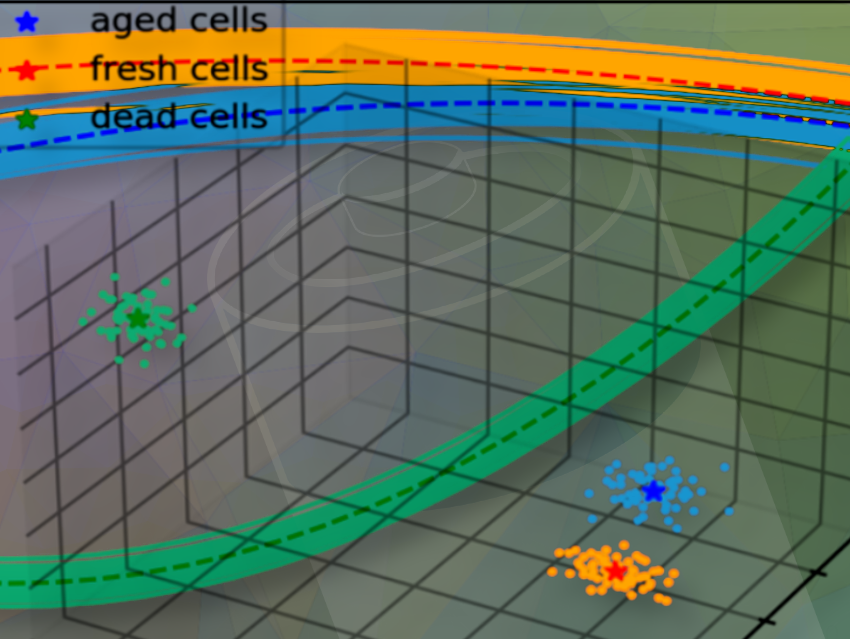Limei Jin, Forschungszentrum Jülich, and Christoph Scheurer, Fritz-Haber-Institut of the Max-Planck-Gesellschaft, Berlin, Germany, together with colleagues, have investigated an advanced modeling approach for lithium-ion batteries to improve the estimation of charging and aging states.
Their study presents a new approach to improve electrochemical impedance spectroscopy (EIS) analysis for better estimating a battery’s state of charge (SoC; the amount of charge currently stored in a battery relative to its maximum capacity) and state of health (SoH; a measure of the overall condition of a battery or fuel cell, indicating how much of its original performance (capacity, efficiency, etc.) remains as it ages).
Traditionally, equivalent circuit models (ECM) are used to analyze the electrochemical responses, but for long-term predictions, a more advanced model—a “digital twin”—is required. In this context, a “digital twin” refers to a highly detailed, dynamic model that simulates the real behavior of a system (in this case, a battery). Unlike traditional models, a digital twin continuously updates and adapts based on real-time data, enabling more accurate long-term predictions of the battery’s performance, aging, and health. The proposed method expands ECM parameters into a high-dimensional space using Chebyshev polynomials, enabling more accurate tracking of both SoC and SoH over time.
What did you do?
We developed a framework that enables the training of big data models starting with very little experimental information and assuming random fluctuations of the model parameters consistent with the available data.
By introducing Chebyshev polynomials and Quasi-Monte Carlo sampling into the ECM parameters, our approach allows for the mapping of SoC dependencies with robust boundary conditions, but also generates synthetic aging data using limited EIS measurements.
Why are you interested in this?
Accurately monitoring a battery’s aging state is crucial for improving battery longevity and reliability in real-world applications. However, conventional ECMs often struggle to capture the complex, dynamic nature of battery degradation. Additionally, conducting EIS measurements across all possible aging states is time-consuming and impractical, as battery degradation varies significantly with usage conditions.
Our methods can bridge the gap between the experiment and purely data-driven techniques, providing a scalable solution for digital twin models and predictive battery management.
What is new and cool about your method?
Unlike traditional ECMs with static parameters, we introduced a Chebyshev-based parameter expansion that dynamically adapts across different SoC levels and aging conditions. We use orthogonal polynomials to compress ECM parameter data into a structured format, mitigating over-fitting issues commonly found in high-order polynomial interpolations.
Additionally, by using QMC sampling, we efficiently adjust these high-dimensional Chebyshev coefficient vectors with minimal experimental data, reducing the need for extensive EIS measurements for model development. This allows the battery state estimation to be progressively refined as more data becomes available.
What is the main significance of your results?
The approach enables synthetic data generation to fill gaps in experimental data, making it possible to refine battery health predictions adaptively as more data becomes available.
Additionally, the structured orthogonal polynomial representation helps to avoid over-fitting, ensuring more robust and scalable battery models. Eventually, this improves battery state estimation by fully considering data gathered up to a certain point in time while maintaining computational efficiency.
What specific applications do you imagine?
This method can contribute to the development of digital twin models for improved battery management and predictive maintenance. In the long term, we aim to integrate it with machine learning techniques to create self-adapting battery models that continuously improve as they accumulate real-world data.
The use of physics-informed synthetic training data, derived from these sampled models, establishes a solid foundation for further AI-driven battery diagnostics and optimization.
What part of your work was the most challenging?
One of the key challenges was ensuring that the ECM parameters remained stable across different battery states while maintaining high accuracy. Achieving a balance between model complexity and computational efficiency was crucial for making this approach both practical and scalable.
Is there anything else you would like to add?
The success of this project was made possible through productive collaboration between colleagues from experiment and theory. While the main focus of the project was theory-oriented, high-quality experimental data was a crucial element for implementing and validating this approach.
Thank you very much for sharing these insights.
The paper they talked about:
- Extending Equivalent Circuit Models for State of Charge and Lifetime Estimation,
Limei Jin, Franz Philipp Bereck, Josef Granwehr, Christoph Scheurer,
Electrochem. Sci. Adv. 2025, e202400024.
https://doi.org/10.1002/elsa.202400024

Limei Jin is a Ph.D. student at the Institute of Energy Technologies – Fundamental Electrochemistry (IET-1) at Forschungszentrum Jülich, Germany.

Christoph Scheurer is a group leader at the Theory Department of the Fritz-Haber-Institut of the Max-Planck-Gesellschaft in Berlin, Germany.




